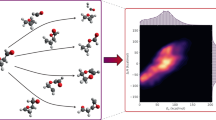Abstract
DEVELOPMENTS in the theory and practice of organic chemistry during the past ten years have opened up a new and broader outlook on organic reactions in general. The reactions of classical organic chemistry, which in the main are concerned with reactions between two molecules or with reactions between an ion and a molecule, have been embraced within a comprehensive electronic theory, the main features of which were firmly established about fifteen years ago. To-day many examples are known of reactions which do not possess the characteristic features of the electronic processes generally referred to as 'electrophilic' or 'nucleophilic', and it is now necessary to consider a third type of reaction, namely, those between a molecule and either an atom or a free radical. Provision for this third type of reaction is obviously necessary, since it is possible to sever a covalent bond in one of two ways, resulting in heterolysis or homolysis, thus:
This is a preview of subscription content, access via your institution
Access options
Subscribe to this journal
Receive 51 print issues and online access
$199.00 per year
only $3.90 per issue
Buy this article
- Purchase on Springer Link
- Instant access to full article PDF
Prices may be subject to local taxes which are calculated during checkout
Similar content being viewed by others
References
Gomberg and Bachmann, J. Amer. Chem. Soc., 46, 2339 (1924).
Grieve and Hey, J. Chem. Soc., 1797 (1934).
Hey and Waters, Chem. Reviews, 21, 169 (1937). Hey, Annual Reports of the Chemical Society, 37, 250 (1940).
Hey, J. Chem. Soc., 1966 (1934).
"Organic Reactions", 2, Ch. 6 (John Wiley and Sons., Inc., New-York, 1944).
Swain and Todd, J. Chem. Soc., 674 (1941).
Ghosh, Pascall and Todd, J. Chem. Soc., 1118 (1940).
Coates, Cook Heilbron, Hey, Lambert and Lewis, J. Chem. Soc., 401 (1943).
Bradbrook, Haworth, Heilbron, Hey and I.C.I., Ltd., U.S.P. 2277629:Haddock and I.C.I., Ltd., B.P.530881.
Brown, Kharasch and Chao, J. Amer. Chem. Soc., 62, 3435 (1940).
Kharasch and Brown, J. Amer. Chem. Soc., 62, 925 (1940).
Kharasch and Brown, J. Amer. Chem. Soc., 64, 329 (1942).
Ziegler et al., Annalen, 551, 80 (1942).
Kharasch and Kleiman, J. Amer. Chem. Soc., 65, 491 (1943).
Price and Tate, J. Amer. Chem. Soc., 65, 517 (1943).
Price and Durham, J. Amer. Chem. Soc., 65, 757 (1943).
Price, J. Amer. Chem. Soc., 65, 2380 (1943).
Breitenbach and Maschin, Z. phys. Chem., A, 187, 175 (1940).
Schulz and Wittig, Naturwiss., 27, 387 (1939).
Schulz, Naturwiss., 27, 659 (1939).
Price and Durham, J. Amer. Chem. Soc., 64, 2508 (1942).
Blomquist, Johnson and Sykes, J. Amer. Chem. Soc., 65, 2446 (1943).
Rights and permissions
About this article
Cite this article
HEY, D. The New Organic Chemistry*. Nature 156, 36–39 (1945). https://doi.org/10.1038/156036a0
Issue Date:
DOI: https://doi.org/10.1038/156036a0
Comments
By submitting a comment you agree to abide by our Terms and Community Guidelines. If you find something abusive or that does not comply with our terms or guidelines please flag it as inappropriate.



